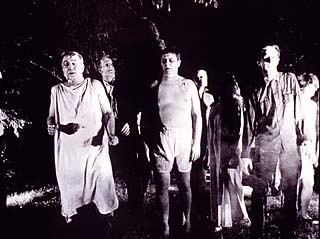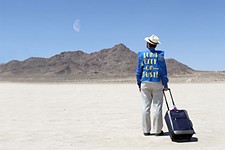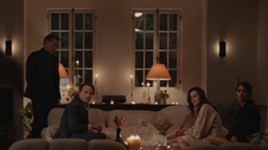American Nightmare
A New IFC Documentary Examines Classic Independent Horror Films
By Marjorie Baumgarten, Fri., Oct. 27, 2000

Two weeks ago on Friday the 13th, as it simultaneously screened during the Austin Film Festival, American Nightmare premiered on the Independent Film Channel, the network that produced this focused documentary study of the American horror film. It continues to screen on the IFC through Halloween, coupled with selected feature films by the maverick directors whose work American Nightmare examines. George Romero (Night of the Living Dead, 1968), Wes Craven (Last House on the Left, 1972), Tobe Hooper (The Texas Chainsaw Massacre, 1974), David Cronenberg (Rabid, 1977), Tom Savini (make-up and special-effects artist, Martin and Dawn of the Dead, 1978), and John Carpenter (Halloween, 1978) are the filmmakers whose seminal work in the late Sixties and Seventies forms the focus of American Nightmare. This documentary persuasively argues that the images and ideology of their groundbreaking films were influenced by the mood of the times. Assassinations, Vietnam, the fuel crisis, the women's movement, the racial divide, and Watergate: All this and more are reflected in these films. Moreover, these films were produced outside the Hollywood boundaries and budgets in cities like Pittsburgh (Romero), Toronto (Cronenberg), and Austin (Hooper).
The Chronicle sat down with American Nightmare director Adam Simon at the Toronto International Film Festival, where his documentary was featured as a midnight movie. Simon, who also directed the IFC's remarkable Sam Fuller documentary, The Typewriter, the Rifle, and the Movie Camera, is also the director of such horror films as Carnosaur and Brain Dead. Thoughtful and passionate about his subject, Simon was especially elated by the enthusiastic response his movie received by the young, midnight-movie crowd more familiar with the slasher films and horror spoofs of the last couple of decades than with these frightening forbears from the Sixties and Seventies. American Nightmare also opens eyes to a time period in which the lines between the personal and the political were blurred and the things that frightened us most were on the evening news.
Austin Chronicle: What are you trying to accomplish with this movie?
Adam Simon: The audience I really intended this for is the Blair Witch kids. And I don't mean the guys who made [the first] Blair Witch, I mean the kids who watched it and were blown away by it. Not to be another old fogey saying, "Oh, it was really radical in the Sixties, and you guys don't know what you missed." But to put these films back into their context. I'm sure they get taught some of this stuff in high school, but I don't think they can possibly imagine what it was like to have your political leaders just gunned down in the street -- again and again and again. Or to see a war continue day after day after day. Or to have the cops or the National Guard shooting students in the street or in the park. It's a way to sneak a history lesson in to young people who love horror movies. In that sense, I hope it will inspire a younger generation to get busy again, both as filmmakers and as citizens. For me, in some ways, the most distressing part of the movie was being forced to recognize how much more radical the press was, the media was, and film was than it is now. That was kind of depressing.
AC: Another context for looking at these particular films is in terms of regional filmmaking, that they were part of a national trend toward local, DIY filmmaking and that they were made by young mavericks working outside the Hollywood conventions.
AS: It makes sense this movie was commissioned by the Independent Film Channel. There were great studio horror movies in that period -- like The Exorcist or Rosemary's Baby. But that's not what this is about. There's a whole other way of looking at these films -- they're not L.A. and they're not New York. They're Austin. They're Pittsburgh. They're Toronto. They're different places. Some of that is just practical. Each of these guys, in one way or another, said, "Here I am, very far from Hollywood. How do I get any damn attention as a filmmaker? Well, make a horror movie." Where did they get the idea to do that? Well, because of George Romero. Because that movie [Night of the Living Dead, 1968] did that. It came out of nowhere, made a fortune, caused a lot of controversy, and got noticed. And that set a pattern.
But then, it's not coincidental that these films could also be so much more radical -- politically, aesthetically, and in other ways. Sometimes they're more radical out of sheer incompetence. Sometimes one of the things that most protects the status quo is craft and quality and ideas about quality. Sometimes it's somebody who doesn't really know what they're supposed to do who breaks the rules in ways that are very exciting. One of the things that was interesting to see was how close to the political events of the time these people were. Someone like Wes Craven was just one step removed from the university. He had just come out of that, and, of course, campuses were the center of radical politics then. You can take a snapshot of what Hollywood was doing in '68-'69. It didn't have much relation to reality. It did pretty soon after that. But I think it took films like this to wake them up. People usually give that credit to Easy Rider. But Night of the Living Dead already has a protagonist shot down at the end -- a black protagonist. George is always at pains to say he didn't know [casting black actor Duane Jones] was doing anything that radical. He was just the best actor he knew. And yet, that's really radical. To this day that's not done in Hollywood, or anyplace else. We do not have color-blind casting of any kind in this country. And that was 30 years ago.
AC: What do you make of the current crop of horror films?
AS: I hope we're just at the beginning of what will be a long cycle of it. I hope that last year's one-two punch of Blair Witch and The Sixth Sense will be like the one-two punch of Night of the Living Dead and Rosemary's Baby 30 years ago. Both came out the same year and seemed to open up the possibilities for that kind of filmmaking. Again, the question we tried to get out of American Nightmare is: Why do we need these kind of films? Especially, why do kids need them? Obviously, kids still need them or we wouldn't have them. We have a generation of kids now who grew up reading these Goosebumps books, quietly devouring this material to the point where a lot of librarians and teachers were mystified. Well, I think the audiences that are fainting and being blown away by Blair Witch are the kids who were reading Goosebumps five years earlier.
I think you see signs of reawakening in the last year or so. It's been so remarkable. A lot of what Blair Witch and The Sixth Sense accomplished was to get away from the tongue-in-cheek. To pull the tongue out of the cheek. To say: This is real, deal with it. A movie is always going to be more interesting when it starts by saying, "Believe me," not when it starts by winking at you, saying, "Don't worry." As much as I might enjoy some elements of the Scream movies, I'm not that interested in movies that wink at me.
AC: What process did you go through to narrow down the film's focus to this specific time period?
AS: I had this very specific idea in my head, which was to literally smash together images -- news images of the times and these films. We're so used to separating movies from reality. Mostly, we receive movies like messages in bottles. They float to us from wherever they were sent. Like all works of art, we can receive them for years and years to come. But, there's something important about putting them back onto the island they came from, as it were. To see what was happening, where they came from. It's important to do that when we can, while the people are alive, while the events are still alive in our hearts so that now people will always be able to connect it.
AC: And there's something to be said for doing film history on film.
AS: I came out of a very academic background myself, especially in terms of film and film studies. And there was a point, say, in the late Seventies or early Eighties, where people started to say that. And it never happened. They never did it. I would like throughout my career to every once in a while do some nonfiction filmmaking -- and particularly nonfiction filmmaking about film. For that very reason. Film criticism and thinking ought to take place within its own medium. Use the medium to reveal the medium. ![]()
For reviews of films featured in American Nightmare, see "Video Reviews"
American Nightmare airs Halloween night, 9pm, on IFC. For more showtimes and other info on American Nightmare see www.ifctv.com.










